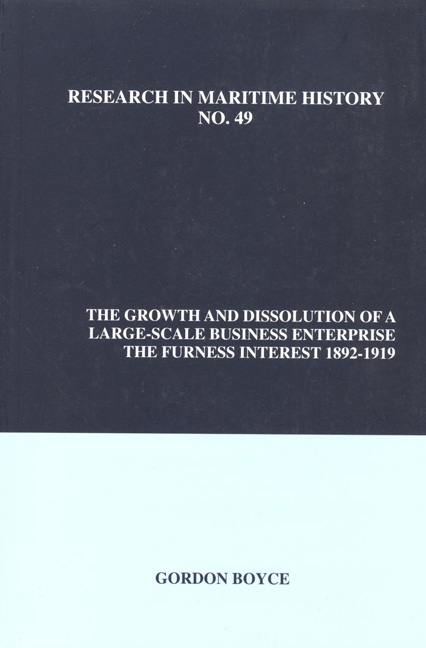Book contents
- Frontmatter
- Table of Contents
- About the Author
- Acknowledgements
- Figures and Tables
- Introduction
- Chapter 1 Furness' Shipping Services: Growth by Organic Means in the 1880s
- Chapter 2 The 1890s: Furness Withy's Expansion by Acquisition and Promotion
- Chapter 3 Diversification into the Industrial Sector, 1895-1901
- Chapter 4 Trouble on the Transatlantic Route: The Formation of the IMM and Furness' Response
- Chapter 5 The Growth of Shipping Services, 1902-1909
- Chapter 6 Industrial Operations and Performance, 1900-1914
- Chapter 7 The Growth of the Shipping Interests, 1910-1919
- Chapter 8 Structure
- Chapter 9 Finance
- Chapter 10 Holding Company Investment Activities and Intermediary Operations
- Chapter 11 Personnel
- Chapter 12 Furness
- Chapter 13 Dissolution
- Appendix 1 Development of the Combined Fleet, 1900-1919
- Appendix 2a Patterns of Ownership: The Furness Group, 1919
- Appendix 2b Reorganization of Branch Offices and Superintending Departments, 1911-1912
- Appendix 3a Fluctuations in Freights, Profits, Tonnage Afloat and Merchant Shipping Output
- Appendix 3b Output of Merchant Tonnage (Excluding Warships), 1892-1913
- Appendix 3c Fluctuations in the Price of a 7500-ton Cargo Steamer, 1898-1913
- Appendix 4 Development of the Furness Group: Principal Promotions, Acquisitions and Divestments, 1880-1919
- Appendix 5 Northern Allies and Maritime Associates
- Appendix 6 Contemporary Accounting Law and Conventions, 1845-1914
- Appendix 7 Lord Furness' Movements, 1899-1912
- Bibliography
Chapter 6 - Industrial Operations and Performance, 1900-1914
- Frontmatter
- Table of Contents
- About the Author
- Acknowledgements
- Figures and Tables
- Introduction
- Chapter 1 Furness' Shipping Services: Growth by Organic Means in the 1880s
- Chapter 2 The 1890s: Furness Withy's Expansion by Acquisition and Promotion
- Chapter 3 Diversification into the Industrial Sector, 1895-1901
- Chapter 4 Trouble on the Transatlantic Route: The Formation of the IMM and Furness' Response
- Chapter 5 The Growth of Shipping Services, 1902-1909
- Chapter 6 Industrial Operations and Performance, 1900-1914
- Chapter 7 The Growth of the Shipping Interests, 1910-1919
- Chapter 8 Structure
- Chapter 9 Finance
- Chapter 10 Holding Company Investment Activities and Intermediary Operations
- Chapter 11 Personnel
- Chapter 12 Furness
- Chapter 13 Dissolution
- Appendix 1 Development of the Combined Fleet, 1900-1919
- Appendix 2a Patterns of Ownership: The Furness Group, 1919
- Appendix 2b Reorganization of Branch Offices and Superintending Departments, 1911-1912
- Appendix 3a Fluctuations in Freights, Profits, Tonnage Afloat and Merchant Shipping Output
- Appendix 3b Output of Merchant Tonnage (Excluding Warships), 1892-1913
- Appendix 3c Fluctuations in the Price of a 7500-ton Cargo Steamer, 1898-1913
- Appendix 4 Development of the Furness Group: Principal Promotions, Acquisitions and Divestments, 1880-1919
- Appendix 5 Northern Allies and Maritime Associates
- Appendix 6 Contemporary Accounting Law and Conventions, 1845-1914
- Appendix 7 Lord Furness' Movements, 1899-1912
- Bibliography
Summary
Furness’ expansion into the industrial sector involved elements of merger, restructuring and re-financing. Many of the firms he acquired were long-standing businesses whose competitiveness had deteriorated, and Furness sought to rejuvenate their fortunes. After securing strategic control, Furness set about modernizing and expanding the productive capabilities of a number of them. In several cases, he pursued product diversification through licensing or internal innovation. These policies marked Furness as a dynamic entrepreneur who attempted to revitalize parts of the North East's established sectors.
Yet these newly-acquired industrial ventures were not all successful. Several firms performed consistently well throughout the period. Others recorded good profits until the severe recession of 1907-1909 eroded demand for their products and brought on serious financial difficulties. A number of these enterprises struggled over many years to recover. Other companies experienced chronic problems from the time Furness took them over and never performed up to initial expectations. Nevertheless, with one exception Furness displayed conspicuously tenacious support for floundering firms.
This chapter examines the operations of the Group's industrial holdings and investigates the reasons for their varied performance. The analysis considers the appropriateness of Furness’ strategy, the effectiveness of policy implementation and the role of broader economic conditions in influencing profitability. In addition, it exposes how allied enterprises supported each other and estimates the extent to which operating and commercial ties arose within the Group.
The Shipyards: Context and Capabilities
Shipbuilding has always been a highly cyclical industry, and appendix 3 shows how the UK's output of merchant shipping oscillated from 1892 to 1913. Production dipped in 1893 and then increased in a series of zigzags to a peak in 1901. A significant setback then occurred as construction fell by twenty percent over the next two years before it then shot up by nearly fifty percent to establish a new high in 1906. Following a financial crisis in the US in 1907, output plunged by over forty percent. After three bad years, the prewar recovery brought a new cyclical peak.
Comprehensive data on the profitability of the shipbuilding industry are not available, but in general terms earnings lagged the cycle as rising mate rial and labour costs cut into margins arising from fixed-price agreements, which were the contractual norm during the period.
- Type
- Chapter
- Information
- The Growth and Dissolution of a Large-Scale Business EnterpriseThe Furness Interest, 1892-1919, pp. 143 - 176Publisher: Liverpool University PressPrint publication year: 2012

